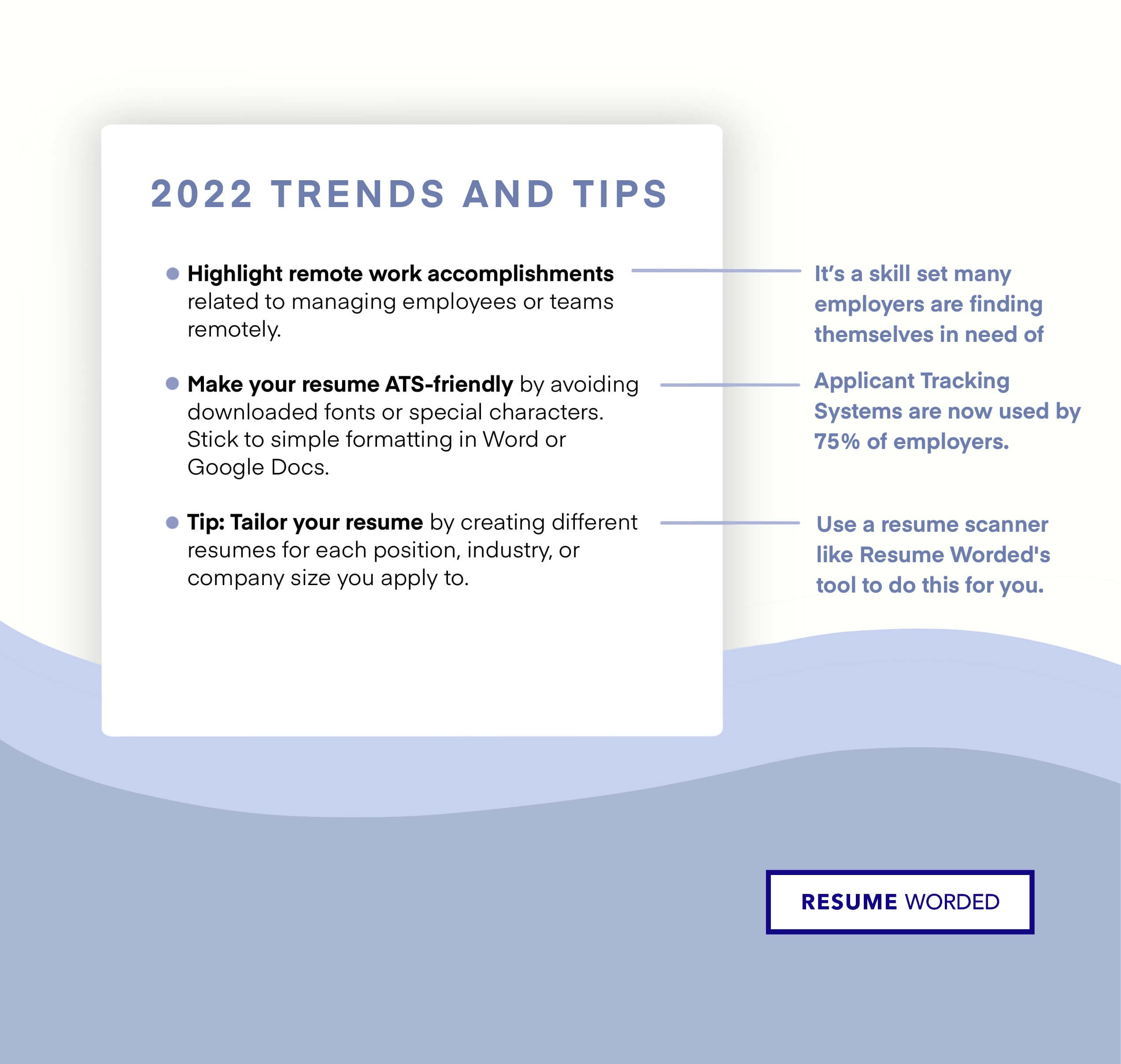If you’re looking to make a major career change, you might have all kinds of questions about how to pull it off. What if you’re a law enforcement officer looking to pursue an IT career or a high school teacher dreaming of becoming a pastry chef?
One of the biggest mistakes career changers make is they reuse their old resume for new job applications. The problem with this is that your old resume is tailored to the very career you want to get out of! It highlights different skills and accomplishments, most of which aren't relevant to the job you're moving into. The result? Hiring managers think you're not a good fit for the new career, role or industry.
Recruiters are going to have questions if your experience doesn't align with the traditional career path they're used to. Does this applicant have relevant experience? Do they have the right skills? Can they do the job? It's your job to answer these questions.
In this guide, we will talk you through how to optimize your resume for a career change, highlight transferable skills, and tailor your resume to your new industry to give you the best chance at success in your new career.
How to write a career change resume
Writing a career change resume isn't exactly the same as writing a regular resume. There are a few extra steps you'll need to consider when revamping your resume to prepare for a career change:
- Add a job title at the start of your resume. This signals to recruiters that you're specifically targeting their industry and can also help get your resume past automated resume scanners (ATS).
- Highlight transferable skills that are relevant to the industry you're changing to.
- Tailor your resume to the new position by including relevant hard skills and keywords.
- Optimize your work experience to highlight relevant accomplishments.
- Use numbers and metrics to show that you can make an impact with your work, regardless of industry.
- Emphasize promotion and career growth.
- Tailor every section of your resume to your new industry. This might mean tweaking your education section to list relevant courses or qualifications, or including any projects or volunteer work adjacent to the industry.
- Address the career change in your cover letter.
Let's take a look at what a career change resume looks like in action.
A resume example for career changers
Before we dive into exactly what recruiters want to see in your resume, here's a sample template for your career change resume that you can use as a foundation to get started:
You can download this career change resume template in Google Docs or as a PDF from our resume templates page.
Pro tip: Include a resume summary
Although we don’t always recommend including a summary on your resume, it can be a smart strategy for career changers. A well-written resume summary will help explain your career change by providing more context and background information about your history and goals, and will help recruiters connect the dots between your prior work experience and the new type of work you want to do.
What should your summary include?
So how do you write a summary if you are changing careers? Your goal is to provide an overall picture of your background and experience in two to six lines of text. Use a tailored job title and mention one or two of your most notable achievements, especially if they’re relevant to the job you’re seeking. Browse our list of resume summary examples for inspiration.
Resume summary template
If you’re new to writing a resume summary, you can model yours after the following template or use our resume summary generator. Just remember to personalize the blank fields with your information:
Former [Current Job Title] transitioning into a [Desired Job Title] position after [earning relevant degree or certification]. Proven track record of doing [X, Y, and Z transferable skills]. [Summarize a major achievement in the format of Action Verb + Accomplishment + Metric].
Here’s an example of how this summary template would look on a real resume:
If you want to find out if your career change resume highlights your transferable skills and relevant accomplishments, upload it to the tool below — it’ll let you know if you’ve shown enough transferable skills and achievements.
Read More: How to write a resume summary if you're changing careers
How to optimize your work experience section for a career change
Your work experience is one of the most crucial parts of your resume - and the first section recruiters oftusuallyen want to read. Here are a few ways you can maximize your work experience section as a prospective career changer:
- Decide what previous experience to include on your resume
- List quantifiable accomplishments in bullet point format
- Use keywords to tailor your resume
- Focus on accomplishments that are relevant to your new career
1: Decide which past work experience to include
When you're navigating a career change, figuring out which past work experiences to include on your resume can be challenging. Should you include everything or just the experience that is relevant to your new career path?
The answer lies in the transferability of your skills. If you've had past experiences where you developed skills directly applicable to your new career, you definitely want to include them. For instance, if you're moving from marketing to sales and you've had a past job where you worked closely with a sales team, it's relevant and should be included.
However, showing progression and continuity in your career is also important. So, even roles that are less relevant to your new job can still be included. You can condense these into an "Other Experience" section, focusing less on the role duties and more on the transferable skills you developed.
2: Use bullet points to explain your experience
On any resume, when writing about your previous work experiences, you should always include brief bullet points that illustrate your accomplishments. Provide specific examples of what you achieved in your past roles, and quantify those examples with specific numbers, as in the examples below:
- Implemented new training initiatives for retail associates that increased quarterly sales by 35%
- Wrote and published 10 articles on the company blog, boosting company website traffic by 50% over 6 months
Bullet points make it easy for recruiters to scan your resume and find the information they’re looking for. For maximum impact, they should include details and data to support your claims about your abilities.
Read more: How to write resume bullets that get interviews
3: Tailor your experience with keywords
A brilliant way to target your resume to each specific job application is to include relevant keywords and skills that recruiters in that field are looking for. But how do you find the right keywords for a brand-new job?
- Read the job posting thoroughly and note the skills they mention. Aim to address each skill with a separate bullet point on your resume.
- Use our skills and keywords finder to browse the industry you're interested in, or type a specific job title into the search bar to get a targeted list of keywords for your resume.
- Upload your resume to our Targeted Resume Tool. This will analyze your resume and the job description you're applying to and tell you what your resume is missing.
Once you have a list of essential keywords, list those skills in your skills section (if they're hard skills like a specific software or programming language), and show how you've used those skills in your work experience through quantified examples and results-orientated phrases.
Read more: How to tailor your resume to a job
4: Emphasize accomplishments that relate to your desired position
One mistake career changers make frequently is to highlight achievements or skills that aren't relevant to the industry they're trying to break into.
Always spin your bullet points to highlight skillsets that your new role or industry is looking for, e.g. if you're breaking into marketing from a customer support role, highlight your experience creating marketing materials or communicating with customers to improve sales.
Here are some examples of how to "spin" your resume accomplishments for different industries:
The field you want to break into: Business analysis
Skills to highlight: Business strategy and data analysis
Old accomplishment: Identified steps to decrease rates of returns and frauds, resulting in 75k in cost savings.
New accomplishment: Implemented new procedures that resulted in annual cost savings of $75k by developing an analysis of current business processes and identifying areas for improvement.
Here's another example:
The field you want to break into: Digital marketing and social media
Skills to highlight: Advertising and customer outreach
Old accomplishment: Sold over 65 company credit cards as part of promotions by answering questions and directing customers to the website, increasing sales by 8%.
New accomplishment: Promoted the company’s marketing programs and digital advertising, resulting in 8% increase in sales and 15% increase in web traffic.
Read more: How to list your work experience on your resume
How to optimize your skills section for a career change
When you're changing careers, it's not just about having skills; it's about showcasing the right skills and demonstrating quantifiable achievements tied to those skills in a way that the hiring manager can't ignore. Your skills section is vital to any resume, but especially for career changers, to show a recruiter that you understand the skills required for the new position and ensure your resume gets past ATS. Here are some tips on creating a competitive skills section:
1: Identify competitive skills
Start by listing your skills, but don't limit yourself to the ones you've used in your old job. Think about your personal qualities, hobbies, or even skills you've developed during your free time or through additional education.
2: Match your skills to the job description
Once you've got your list, pull up the job posting and identify the skills they specifically mention in the job description. Match your skills and their related achievements with those listed in the job description. Remember, even if your experience is in a totally different field, there is always a transferable skill hidden somewhere.
3: Focus on hard skills, not soft
While soft skills are always important, hard skills take center stage in your skills section when you're making a career change. These are the tangible, technical skills that directly relate to the job you're applying for.
Your soft skills, like 'good communicator' or 'team player', should not be listed in your skills section. Instead, use your work experience section to demonstrate these skills through concrete examples, metrics, and quantifiable achievements.
4: List your skills by industry
As your skills will likely cover a range of industries, it is best to organize your skills section by industry or category, so a recruiter can easily pick out your relevant skills. Here is an example of how to list your skills by industry:
5: If you’re missing an essential skill
If you find you're lacking a crucial skill, consider enrolling in an online course or professional development program to bridge the gap. Demonstrating your initiative to learn and adapt will make a positive impression on potential employers, and you can always include an ‘in-progress’ qualification on your resume to show your continued education.
How to tailor your resume to your new industry
Diving into a new field can be daunting. But fear not! By strategically emphasizing transferable skills and relevant qualifications, you can make a strong impression on potential employers and show dedication to your new field.
1: Emphasize transferable skills
Transferrable skills are not specific to one industry and can be 'transferred' to another. Unlike the hard skills mentioned earlier, transferable skills aren't generally keywords you want to list at the end of your resume, but instead, should be illustrated through specific bullet point examples.
Transferable skills will form the backbone of your career change resume. Unlike technical skills, which you might not have mastered yet, or industry-specific experience, transferable skills are always relevant.
Here are some examples of bullet points that demonstrate commonly required soft skills:
- Leadership: Led the transition to a paperless practice by implementing an electronic booking system, resulting in cost savings of labor by 30% and office overhead by 10%.
- Teamwork: Collaborated with community outreach team to organize monthly fundraising events, raising over $50,000 in donations within three months.
- Communication: Collaborated with a team of 10+ remote developers and senior leadership team to assess project outcomes and prioritize future features.
- Initiative: Overhauled service delivery processes, leading to a 70% increase in customer satisfaction.
2: List relevant courses and qualifications
It’s wise for career changers to list relevant education or certifications on their resumes. You may not need to go back to school, unless you’re trying to enter a specialized field (such as law or medicine), but it might be beneficial to take a quick class or two to give you a jump start in your new career.
Certain fields, such as project management, IT, or finance, might require a specific certificate. If you complete these qualifications before applying for jobs, potential employers can see that you’re serious about your new choice of career and that you’ve already taken steps to make it happen.
Here is an example of how to list certificates and qualifications on your resume:
Example of how to list your certificates and qualifications on a career change resume.
Read more: How to list certifications on a resume
3: Include projects and volunteer work
If your work history is more sparse than you’d like, or if your job experiences don’t adequately reflect your relevant skills, you can also showcase other projects and volunteer work. Projects are an excellent way for career changers to show hiring managers that they have practical skills for the new role and allow you to include keywords for the new job on your resume.
Let’s imagine you are seeking a job as a software developer, and you spent one month last summer developing a phone app. Here’s how you might showcase this project on your resume:
InstaGrub Developer
- Technologies used: Python, Redux, PostgreSQL, Express.js
- Designed architecture and user interface of mobile app for grocery delivery
- Enabled users to purchase food from 15+ grocery store chains
The same can be said for volunteer positions. Volunteering may not always be financially realistic, but you can build experience and get your foot in the door in a new area of interest. It also shows recruiters that you are committed to your new chosen field.
Read more: How to list projects on a resume
Pro tip: Address a career change in your cover letter
A cover letter is a great way to make a strong first impression on a hiring manager and provide background on your career transition.
When addressing a career change in your cover letter, start by openly discussing your transition and connecting it to the desired new role. Then, highlight your transferable skills, express your passion for the new field, and reassure the employer of your commitment to this career path.
Read more: Sample cover letters
The best format for a career change resume
Reverse chronological order is the most common format for your resume, where you detail your most recent work experience first. Recruiters prefer this format as it shows clear career progression and makes your most recent experience easy to find.
However, for a career change, you may want to rearrange your work experience into two sections, titled "Relevant Experience" and "Other Experience", to better highlight your transferable skills without leaving gaps in your resume.
Functional resumes, which focus on skills over chronological experience, are typically not recommended due to their lack of clarity and potential to appear vague.
FAQ
Do employers care about previous unrelated experience?
Yes and no. If you have some experience (including volunteer work, projects, or education) related to your new field, it's okay to leave off older work experience that is no longer relevant. Remember that your resume doesn’t have to provide a complete picture of your work history, just your most recent accomplishments.
If you lack any relevant experience or qualifications, then yes, it's a good idea to include all of your work history on your resume to show your career progression and focus on the more relevant parts by splitting your work history into "Relevant Experience" and "Other Experience".
What if my skills aren’t directly relevant to the new career?
If your previous skills don’t directly apply to your new career, don't panic! First, look beyond the obvious. It's easy to underestimate the transferability of your skills. For instance, you might not think that your time management skills as a project manager would matter much in a sales rep career, but managing multiple leads, follow-ups, and deals at once requires good time management. Most jobs will have at least one transferable skill you can highlight on your resume.
If you genuinely feel you lack any relevant skills, consider taking additional training (like online courses), starting a side project, or participating in an internship.
How do I make myself stand out amongst candidates who have direct experience?
To stand out, focus on your transferable skills, major achievements, and willingness to adapt. Show how your unique experiences bring a fresh perspective. Include instances where you've excelled or driven results in past roles, even in different industries, and remember to mention any relevant training or certifications that equip you for the new position.
What other information should I include?
We’ve covered the essential sections that your resume needs: your summary, work experience, relevant education and hard skills. Some job seekers like to include other sections, such as language proficiency; feel free to include this information as long as it relates to the job and enhances your application. If it’s not relevant, it’s best to leave it out.
I'm struggling to get started – do you have any other tips for career changers?
In a word: Networking! Take time to reach out to people you know in your new field. Find events and ways to meet new people, connect with them on LinkedIn, or set up informational interviews. The more people you know, the easier and faster it will be to launch your new career.










